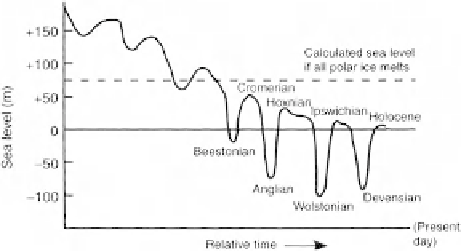Geology Reference
In-Depth Information
Figure 11.5.
Generalized sequence of Quaternary sea-level changes. From Pethick (1984, pp.
220-221).
last Weichselian glacial maximum approximately 18ka ago (Laban and van der Meer,
2004, p. 257).
Most discussion of Pleistocene-age shorelines usually centers upon glacio-isostatic
rebound and raised beaches (Sissons, 1981; Synge, 1981; West, 1977, pp. 151-179) . Moreo-
ver, if one accepts the “staircase” theory of Quaternary sea-level change (Figure 11.5) and
ignores isostatic and tectonic uplift, it follows that shorelines and/or beach deposits directly
related to the low sea levels of the Pleistocene are rare, preserved only in the stratigraphic
record. For example, the well-known Pleistocene raised beaches that are found along the
coasts of southern England and generally ascribed to marine oxygen-isotope stages 9, 7,
and 5e (Bates et al., 2003; Davies and Keen, 1985), are covered by solifl uction or “head”
deposits (see Chapter 12). Their present elevation is the result of the slow uplift of the
coastal zone caused by isostatic response to sediment unloading during accelerated phases
of erosion in the cold stages (Bates et al., 2003).
In theory, on stable coastlines constructed in frost-susceptible bedrock, the combina-
tion of intense frost action and marine action should lead to well-developed coastal fea-
tures such as cliffs, shore platforms, and beaches. For example, the coastline of the
maritime Antarctica refl ects the combination of recent deglaciation, isostatic uplift, and
current marine action. However, the formation of similar shorelines during the cold stages
of the Pleistocene is problematic, and the extent, nature, and duration of Pleistocene sea
ice are highly speculative.
11.3.2. Uplift of Qinghai-Xizang (Tibet) Plateau
The Tibet Plateau is a vast upland that ranges in elevation from approximately 4000 meters
a.s.l. to over 5000 meters a.s.l. Uplift commenced at the end of the Pliocene as the Indian
and Eurasian plates collided. During the Quaternary, it is estimated that at least 3500 m
of uplift has occurred. Uplift was especially rapid during the Late Pleistocene with rates
of more than 10 mm/year (i.e. 1500-2000 m over the last 130 ka). Differential movement
(faulting, geothermal springs) accompanied uplift. Today, the Kunlun and Himalayan
mountain chains, to the north and south respectively, are youthful landscapes character-
ized by slope instability and rapid stream incision.
Just as the separation of the Antarctic Plate during Late Tertiary times helped create
the strong zonal wind belt in the southern hemisphere mid-latitudes, so uplift of the Tibet
Plateau affected the zonal wind systems of the northern hemisphere during the Quater-
nary. Penetration of monsoon wind into central Asia was prevented and the central

